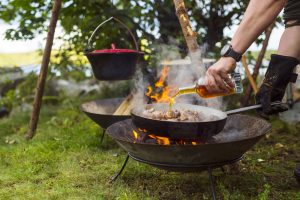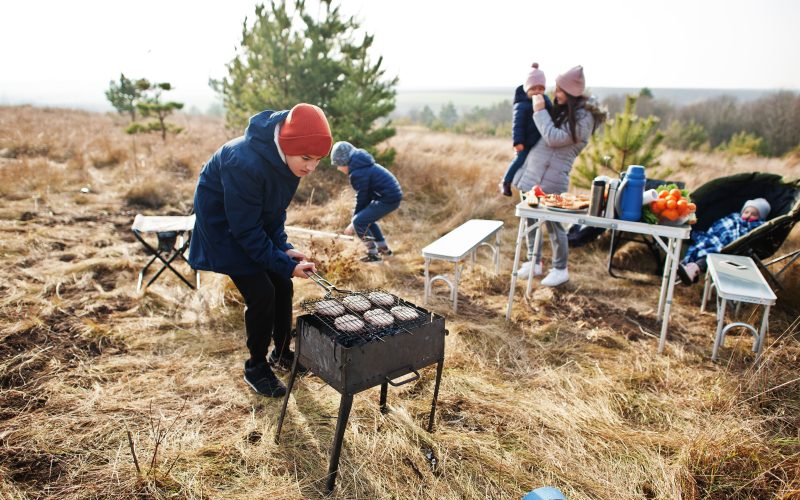Outdoor cooking offers a chance to enjoy fresh air, delicious meals, and meaningful connections with others. Whether grilling in your backyard or preparing a hearty campfire meal, cooking outdoors enhances flavor and adds a unique element to your meals. Nature Quest Journal highlights how outdoor cooking brings together simplicity, fun, and nature to create unforgettable experiences.
What Is Outdoor Cooking?
Outdoor cooking involves preparing meals with grills, smokers, or open flames. Grilling adds a smoky flavor while cooking over embers sweetens veggies. Dutch ovens are perfect for slow-cooked dishes like stews. This cooking style sparks creativity, letting you experiment with flavors and techniques. Whether a beginner or pro, outdoor cooking brings people together and creates lasting memories.
Benefits of Outdoor Cooking
 Outdoor cooking provides a refreshing break from indoor activities and offers vitamin D through exposure that promotes good health. A campfire or barbecue makes for an unforgettable meal with a great sense of taste and smell. Furthermore, it preserves the smell of food inside your house and reduces energy-intensive equipment usage, which is advantageous in warmer weather. Additionally, the utilization of unprocessed ingredients in outdoor cooking promotes healthier eating habits.
Outdoor cooking provides a refreshing break from indoor activities and offers vitamin D through exposure that promotes good health. A campfire or barbecue makes for an unforgettable meal with a great sense of taste and smell. Furthermore, it preserves the smell of food inside your house and reduces energy-intensive equipment usage, which is advantageous in warmer weather. Additionally, the utilization of unprocessed ingredients in outdoor cooking promotes healthier eating habits.
Essential Outdoor Cooking Equipment
For cooking outdoors, important implements such as a strong spatula, tongs, and a grill brush facilitate preparation and cooking. A Dutch oven, skewers, or a cast-iron pan enhances flexibility. Travelers can choose portable, lightweight tools that can be collapsed. Outdoor cooking kits, such as the Gerber ComplEAT 16-piece set, provide all the essentials for easy meal preparation.
Fuel Options for Outdoor Cooking
Choosing the right fuel impacts ease and flavor. Charcoal adds smokiness, propane heats quickly and is adjustable, while wood gives a campfire aroma. For eco-friendly options, solar cookers use renewable energy. Consider the weather and your style—propane is ideal for windy days, and wood for a traditional vibe.
Choosing the Right Cookware
Cast iron excels in outdoor cooking as it retains heat effectively and can be utilized for numerous recipes. Stainless steel is long-lasting and ideal for boiling or steaming, whereas non-stick cookware is simple to clean but requires cautious handling. Compact sets such as the Gerber ComplEAT are perfect for individuals seeking a complete range of essentials in a compact, portable kit.
Outdoor Cooking Techniques and Methods
Outdoor cooking offers various methods, each adding unique flavors. Grilling gives a smoky, charred taste; baking lets you get creative with dishes like bread; and smoking adds depth to meats. Combining methods, like smoking ribs and finishing on the grill, can create a rich, flavorful crust.
1. Grilling Basics for Beginners
 Grilling is easy and popular. Use direct heat for quick-cooking foods like burgers and indirect heat for slower dishes like roasted chicken. Preheat the grill to cook evenly and prevent sticking. Simple marinades with olive oil, garlic, and herbs enhance flavor, and a meat thermometer ensures the right cooking temperature.
Grilling is easy and popular. Use direct heat for quick-cooking foods like burgers and indirect heat for slower dishes like roasted chicken. Preheat the grill to cook evenly and prevent sticking. Simple marinades with olive oil, garlic, and herbs enhance flavor, and a meat thermometer ensures the right cooking temperature.
2. Mastering Campfire Cooking
Cooking over an open fire uses traditional methods. Skewers are lovely for hot dogs and vegetables; a grate is ideal for steaks and corn. Dutch ovens and cast-iron skillets give a good spread of heat. Never be far from a source of water or sand to douse the fire, and use long-handed tools to avoid getting scorched.
3. Using Portable Stoves Effectively
Portable stoves are great for quick outdoor meals. Propane stoves are convenient, while butane stoves are more portable. Set up your stove on stable, flat ground for safety.
4. Exploring Dutch Oven Cooking
Dutch ovens are versatile and ideal for baking bread or stewing meats. They distribute heat evenly over coals, creating rich, flavorful dishes. A well-seasoned Dutch oven can last for years and is a must for outdoor cooking.
5. Smoking Meat Outdoors
Meats such as chicken, brisket, and ribs gain a deep taste via smoking. For optimal results, keep the temperature between 225°F and 250°F. For distinct flavors, experiment with different wood chips, such as applewood or honey.
6. Baking Outdoors with Ease
Outdoor baking is a great way to prepare bread, cookies, and desserts.? The best portable ovens are for pizza or cakes, while the most effective ones are Dutch ovens for baking bread.
7. Cooking on Open Flames Safely
Maintain a safe distance for flammable items from the cooking space and utilize tools with long handles. Remove extra fat to avoid flare-ups and make sure the fire is completely out when finished.
Safety Tips for Outdoor Cooking
 Keep dry leaves or grass around your kitchen to avoid catching fire. In an emergency, ensure the fire is completely contained and store any spare change or sand.
Keep dry leaves or grass around your kitchen to avoid catching fire. In an emergency, ensure the fire is completely contained and store any spare change or sand.
Washing hands, keeping raw meats separate from other foods, utilizing a cooler with ice packs for perishable items, and sanitizing surfaces and utensils are effective methods to maintain safety.
Best Practices for Successful Outdoor Meals
Planning is essential for smooth outdoor cooking. Prepare ingredients in advance and choose recipes suited to the equipment available. Pack essential cooking tools like tongs and meat thermometers to ensure everything goes smoothly. Always be prepared for weather changes, as rain or wind may affect your cooking plans.
Delicious Recipes for Outdoor Cooking
Outdoor cooking lets you try new recipes with simple ingredients and flavors. Foil packet dinners or one-pot meals are perfect for outdoor cooking. As you experiment, you’ll improve your skills and create memorable meals. A custom recipe book can make future trips easier.
Easy Breakfast Recipes for Outdoors
- Add dried fruits and nuts for a quick, nutritious boost.
- Fill tortillas with scrambled eggs, cheese, and pre-cooked sausage.
- Use pre-mixed batter and a portable griddle for easy flipping.
A solid breakfast fuels the day ahead, especially when outdoors. Prepping ingredients like chopping vegetables or making cake batter saves time. Getting everyone involved adds fun and teamwork.
Quick Lunch Ideas for Camping
- Use whole-grain bread with fillings like turkey or cheese.
- Wraps: Add roasted veggies or sliced meat for a filling option.
- Toss pre-washed greens with nuts or grilled chicken.
Easy, quick lunches keep your energy up. Leftovers from breakfast or dinner—like grilled veggies or proteins—make for a simple, waste-free lunch.
Hearty Dinner Recipes for Grilling
- Grilled Steaks: Season with your favorite rub or marinade.
- Combine bell peppers, zucchini, and mushrooms for a savory flavor.
- Foil Packet Meals: Include chicken, potatoes, and seasoning for a no-cleanup option.
After a long day outdoors, a big dinner recharges you. Marinate meats ahead of time for extra flavor and less grill time. Try smoking pork loin for a fun twist.
Sweet Desserts Made Outdoors
- Use Graham crackers, chocolate, and marshmallows for a classic treat.
- Bake seasonal fruits in a Dutch oven.
- Core apples, stuff with cinnamon and sugar, wrap in foil, and bake.
Desserts are a great way to end an outdoor meal. Prep ingredients like fruits and spices ahead of time for an easy cook. Seasonal flavors like fresh berries can make for delicious cobblers.
Expert Tips for Outdoor Cooking Success
Outdoor cooking is a fun way to try new recipes and improve your skills. Experiment with marinades, attend workshops, and stay flexible with challenges like weather to make the most of your outdoor meals.
Improving Your Cooking Skills Outside
Outdoor cooking takes practice and creativity. Try new recipes, like a BBQ rub or marinade, to explore fresh flavors.
One great way to learn is through attending outdoor cooking workshops. You’ll learn techniques like direct vs. indirect grilling and how to create a two-zone setup for better results.
Troubleshooting Common Challenges
Cooking outside presents challenges, like weather changes or equipment failure. Stay flexible with extra fuel or batteries, adjust cooking times, and use a two-zone setup to control heat.
With a bit of creativity, outdoor cooking can be both fun and rewarding!
The Joy of Outdoor Cooking: More Than Just a Meal
Outdoor cooking isn’t just about the food; it’s about the experience. So grab your gear, get creative with your recipes, and make memories with loved ones. Nature Quest Journal invites you to step outside and enjoy the simple joy of cooking in nature—you won’t regret it!

